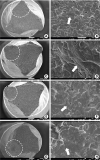1. Cheung GS, Liu CS. A retrospective study of endodontic treatment outcome between nickel-titanium rotary and stainless steel hand filing techniques. J Endod. 2009; 35:938–943.

2. Sattapan B, Nervo GJ, Palamara JE, Messer HH. Defects in rotary nickel-titanium files after clinical use. J Endod. 2000; 26:161–165.

3. Ullmann CJ, Peters OA. Effect of cyclic fatigue on static fracture loads in ProTaper nickel-titanium rotary instruments. J Endod. 2005; 31:183–186.

4. Lopes HP, Moreira EJ, Elias CN, de Almeida RA, Neves MS. Cyclic fatigue of ProTaper instruments. J Endod. 2007; 33:55–57.

5. Capar ID, Ertaş H, Arslan H. Comparison of cyclic fatigue resistance of novel nickel-titanium rotary instruments. Aust Endod J. 2015; 41:24–28.

6. Yared G. Canal preparation using only one Ni-Ti rotary instrument: preliminary observations. Int Endod J. 2008; 41:339–344.

7. Plotino G, Grande NM, Testarelli L, Gambarini G. Cyclic fatigue of Reciproc and WaveOne reciprocating instruments. Int Endod J. 2012; 45:614–618.

8. Shen Y, Coil JM, Mo AJ, Wang Z, Hieawy A, Yang Y, Haapasalo M. WaveOne rotary instruments after clinical use. J Endod. 2016; 42:186–189.

9. West JD. The endodontic Glidepath: “Secret to rotary safety”. Dent Today. 2010; 29:86–88.
10. D'Amario M, Baldi M, Petricca R, De Angelis F, El Abed R, D'Arcangelo C. Evaluation of a new nickel-titanium system to create the glide path in root canal preparation of curved canals. J Endod. 2013; 39:1581–1584.
11. Gambarini G, Rubini AG, Al Sudani D, Gergi R, Culla A, De Angelis F, Di Carlo S, Pompa G, Osta N, Testarelli L. Influence of different angles of reciprocation on the cyclic fatigue of nickel-titanium endodontic instruments. J Endod. 2012; 38:1408–1411.

12. Uslu G, Özyürek T, İnan U. Comparison of cyclic fatigue resistance of ProGlider and one G glide path files. J Endod. 2016; 42:1555–1558.

13. Pruett JP, Clement DJ, Carnes DL Jr. Cyclic fatigue testing of nickel-titanium endodontic instruments. J Endod. 1997; 23:77–85.

14. Lopes HP, Britto IM, Elias CN, Machado de Oliveira JC, Neves MA, Moreira EJ, Siqueira JF Jr. Cyclic fatigue resistance of ProTaper universal instruments when subjected to static and dynamic tests. Oral Surg Oral Med Oral Pathol Oral Radiol Endod. 2010; 110:401–404.

15. Yao JH, Schwartz SA, Beeson TJ. Cyclic fatigue of three types of rotary nickel-titanium files in a dynamic model. J Endod. 2006; 32:55–57.

16. De-Deus G, Leal Vieira VT, Nogueira da Silva EJ, Lopes H, Elias CN, Moreira EJ. Bending resistance and dynamic and static cyclic fatigue life of Reciproc and WaveOne large instruments. J Endod. 2014; 40:575–579.

17. Blum JY, Machtou P, Ruddle C, Micallef JP. Analysis of mechanical preparations in extracted teeth using ProTaper rotary instruments: value of the safety quotient. J Endod. 2003; 29:567–575.

18. Ha JH, Park SS. Influence of glide path on the screw-in effect and torque of nickel-titanium rotary files in simulated resin root canals. Restor Dent Endod. 2012; 37:215–219.

19. Berutti E, Paolino DS, Chiandussi G, Alovisi M, Cantatore G, Castellucci A, Pasqualini D. Root canal anatomy preservation of WaveOne reciprocating files with or without glide path. J Endod. 2012; 38:101–104.

20. Elnaghy AM, Elsaka SE. Evaluation of root canal transportation, centering ratio, and remaining dentin thickness associated with ProTaper Next instruments with and without glide path. J Endod. 2014; 40:2053–2056.

21. Berutti E, Alovisi M, Pastorelli MA, Chiandussi G, Scotti N, Pasqualini D. Energy consumption of ProTaper Next X1 after glide path with PathFiles and ProGlider. J Endod. 2014; 40:2015–2018.

22. Alovisi M, Cemenasco A, Mancini L, Paolino D, Scotti N, Bianchi CC, Pasqualini D. Micro-CT evaluation of several glide path techniques and ProTaper Next shaping outcomes in maxillary first molar curved canals. Int Endod J. 2017; 50:387–397.

23. Ruddle CJ, Machtou P, West JD. Endodontic canal preparation: innovations in glide path management and shaping canals. Dent Today. 2014; 33:118–123.
24. Özyürek T, Uslu G, Yılmaz K, Gündoğar M. Effect of glide path creating on cyclic fatigue resistance of Reciproc and Reciproc Blue nickel-titanium files: a laboratory study. J Endod. 2018; 44:1033–1037.

25. Türker SA, Sağlam BC, Koçak MM, Koçak S. The effect of glide path on the surface quality of new and used rotary and reciprocating single files: OneShape versus WaveOne. Scanning. 2014; 36:608–613.

26. Kuhn G, Tavernier B, Jordan L. Influence of structure on nickel-titanium endodontic instruments failure. J Endod. 2001; 27:516–520.

27. Cheung GS, Oh SH, Ha JH, Kim SK, Park SH, Kim HC. Effect of torsional loading of nickel-titanium instruments on cyclic fatigue resistance. J Endod. 2013; 39:1593–1597.

28. Cunha RS, Junaid A, Ensinas P, Nudera W, Bueno CE. Assessment of the separation incidence of reciprocating WaveOne files: a prospective clinical study. J Endod. 2014; 40:922–924.

29. Karova E, Topalova-Pirinska S. The influence of a glide path on the lifespan of WaveOne reciprocating files. Int J Dent Sci Res. 2014; 2:59–62.







 PDF
PDF Citation
Citation Print
Print



 XML Download
XML Download